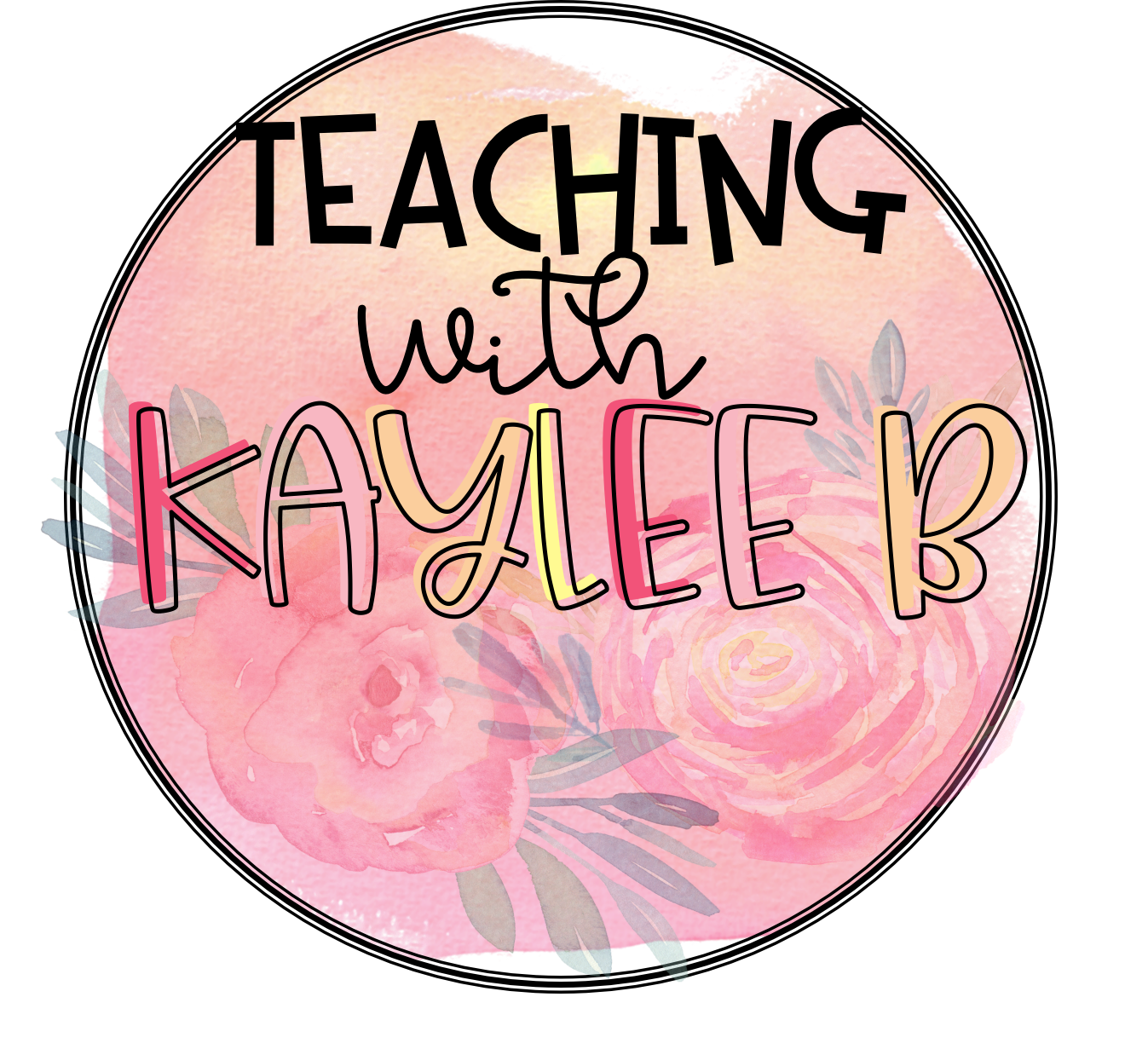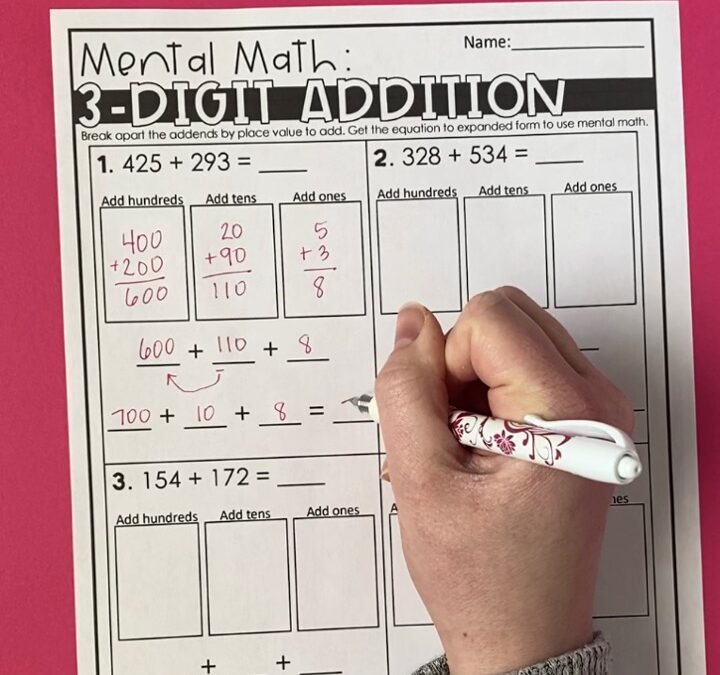Mental math is one of the most powerful things we can teach to students. I am always so curious on how different people solve different math equations in their heads. When we do mental math, we are flexible with the numbers to make them easier to work with. And because of this, it is so important that we give students mental math addition practice so that they can use this important skill throughout their lives.
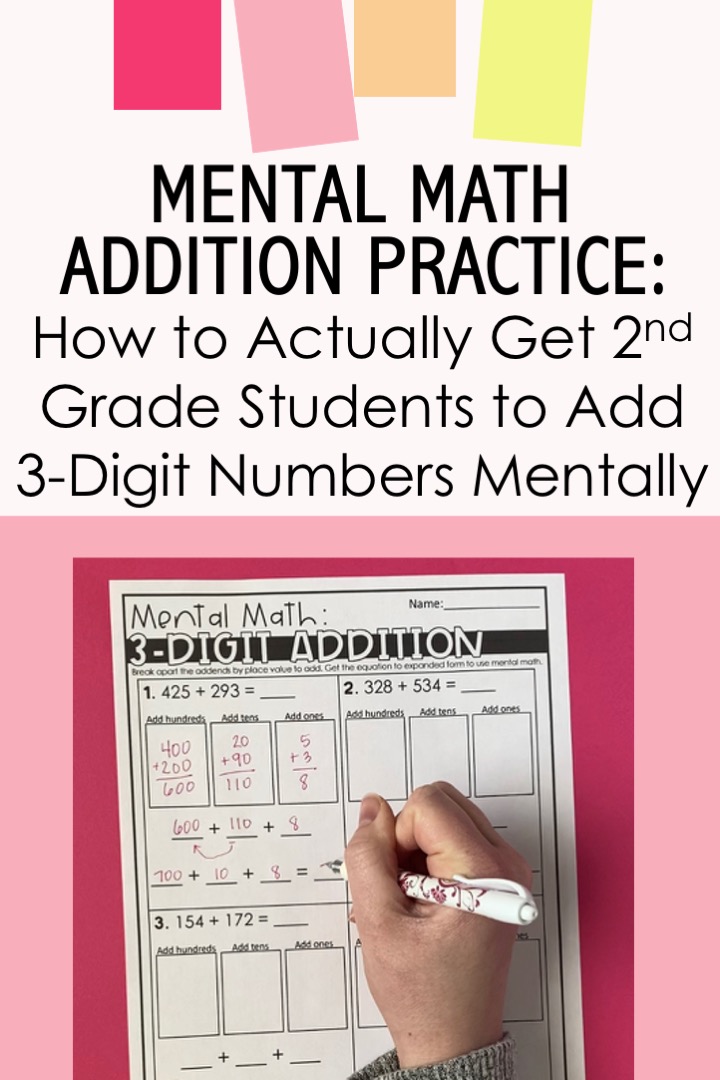
When you give students plenty of mental math addition practice, they will be able to add 3-digit numbers in their heads by following place value concepts.
But for most 2nd grade students, it doesn’t come instantly. They need direct instruction on how to use mental math for 3-digit addition. Then they need lots of mental math addition practice where they can take the reasoning they have written down and do it entirely in their heads. So today I thought I would share how I teach the 3-digit mental math strategy to my 2nd grade students.
But before we get started, it’s important to know that students do much better on these 3-digit addition strategies when they are fluent with their basic addition and subtraction math facts. I have a free workbook to help you get your students to math fact fluency: The 7 Steps to Ensure Math Fact Fluency. Download your free copy here.
Mental Math: What Is It
The 3-digit mental math addition strategy has students break the numbers in the equation down to add the hundreds, tens, and ones together. They add those to get the expanded form of a number. Then students can easily use mental math to put that number in standard form.
Let’s look at an example with this equation: 425 + 293
First, add the hundreds: 400 + 200 = 600
Then, add the tens 20 + 90 = 110
Next, add the ones: 5 + 3 = 8
Then take those numbers and add them: 600 + 110 + 8. This isn’t quite expanded form yet, because there is a hundred in the tens number. So you would give the hundred in 110 to the 600 to make the equation 700 + 10 + 8. Finally, you add those numbers to get the answer, 718.
For students to be able to do this skill, they need to understand some important place value concepts.
They need to first understand that a 3-digit number has hundreds, tens, and ones. I like to teach this to my students with base ten blocks. This helps students see that in a number like 425, there are 4 hundreds or 400, 2 tens or 20, and 5 ones or 5.
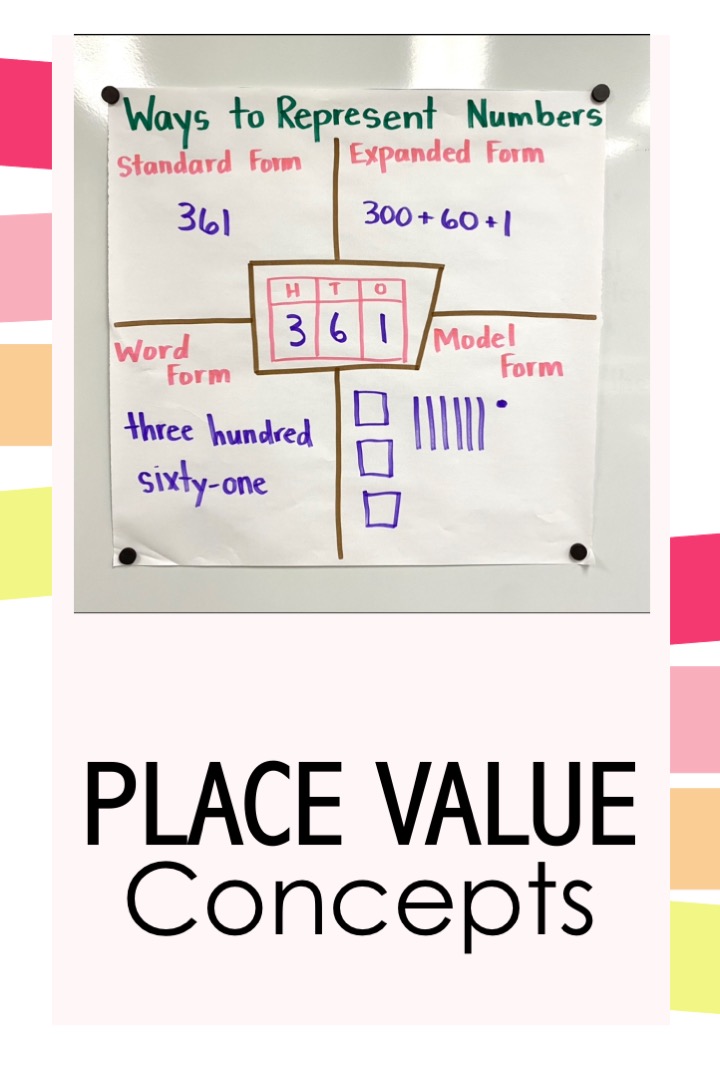
If you want your 2nd grade students to add using mental math, you will first need to teach important place value concepts.
Students also need to know the expanded form and the standard form of numbers and how they relate to each other. I love to point out to students that when we have an expanded form of a number, we can just “squish” the number together by taking out the zeros and plus signs to just get the standard form.
Then I show students how to name the same number or how to be flexible with numbers. To do this, I make an anchor chart. I split the page into three sections. Then I show how to write a number in 3 different ways.
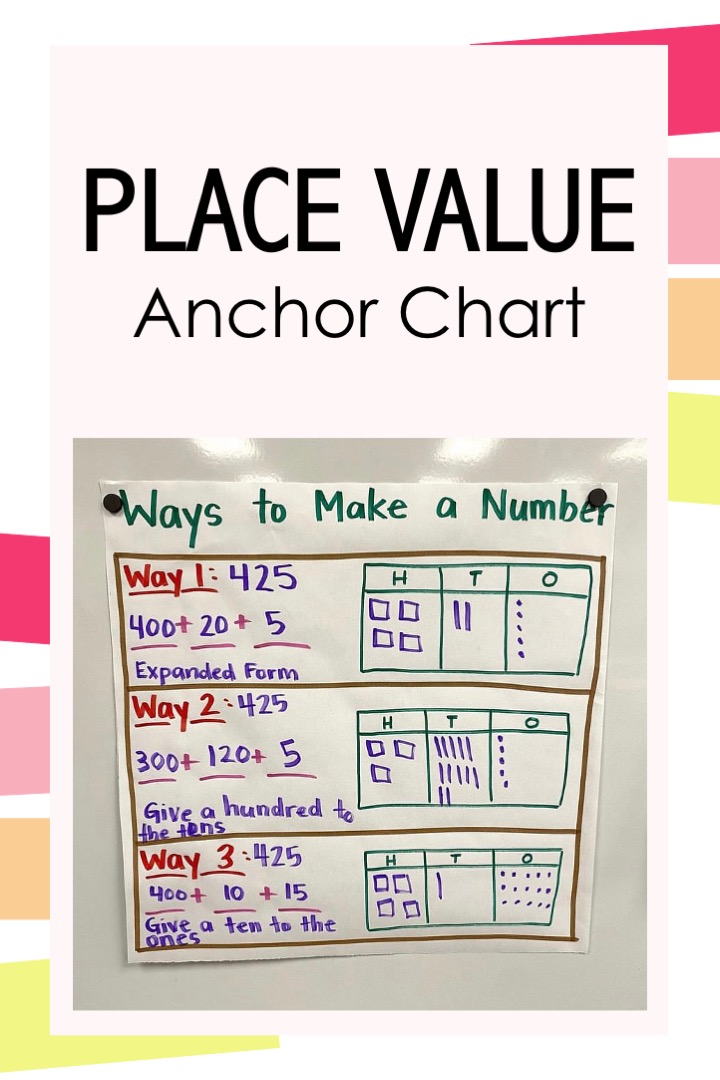
For students to add using mental strategies, they need to be flexible with numbers. This place value anchor chart helps me teach my 2nd grade students how to be flexible with 3-digit numbers.
The first way is just normal expanded form. I also show this by drawing base ten blocks. The second way shows giving a hundred to the tens. I draw a picture of base ten blocks so students can see this equation is still the same amount as the expanded form one. For the third way, I show giving a ten to the ones. And once again, I show it with base ten blocks so students can see they equal the same amount.
Learn more about how I teach these place value concepts in this blog post here: Place Value Standards: How to Best Teach Them to 2nd Grade Students
Find my place value practice activities here.
Once students understand these, they are ready for mental math addition practice.
Mental Math Addition Practice
I first like to explicitly teach this strategy. I display a page that gives a 3-digit addition equation and shows the numbers broken down and added up according to place value. There’s a box to add the hundreds, a box to add the tens, and a box to add the ones. Then underneath is space to write an equation where you add up the sums you got in the boxes. I show moving around any hundreds or tens to put the equation in expanded form. That way we can easily get to the answer.
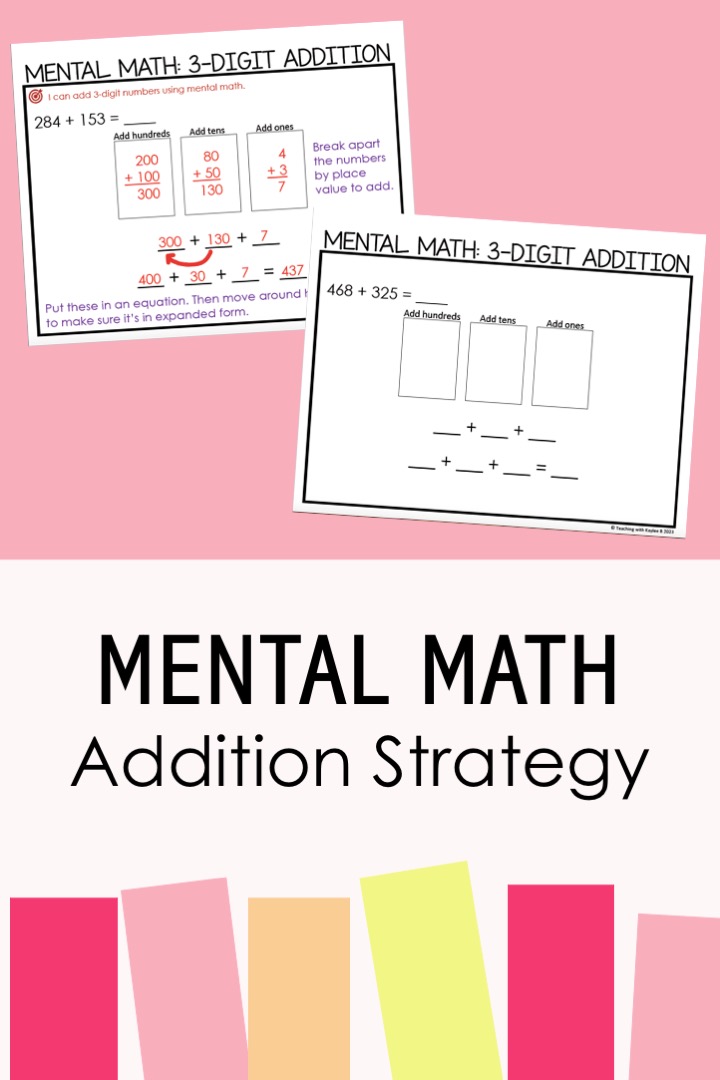
These display pages make it easy to explicitly teach this mental math addition strategy to my 2nd grade students.
I explain this all to students and then have a few display pages that allow me to continue to model this strategy to students. I ask students questions as I solve them to involve them and to get them thinking about the steps.
After we practice a few problems with the boxes, I tell students that we can do that step in our heads. I then underline the hundreds numbers in the equation and ask students, “what is 2 hundreds plus 6 hundreds?” They will answer 8 hundreds and I’ll ask them, “how much is 8 hundreds?” They will say 800 and I will write that in the equation frame. We continue this with the tens and ones. We shift around any hundreds or tens to make the equation be in expanded form. And finally “squish” the number to the standard form to get to our answer.
I also like to show a couple examples where I “think aloud” to my students and explain to them my reasoning as I solve a couple problems.
Then students are ready to get some of their own mental math addition practice.
Mental Math Addition Worksheets
I like to start my students with mental math addition worksheets that have the boxes. I also display this same worksheet up on my board. We complete a few problems together and I have students complete the rest by themselves.
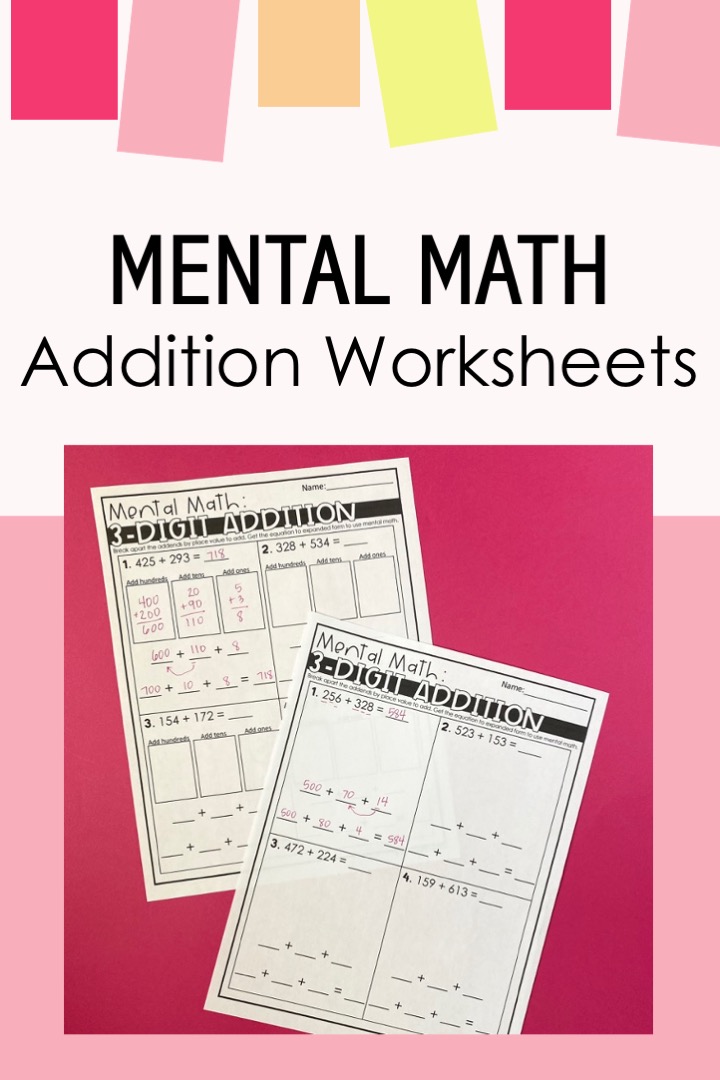
These mental math addition worksheets help support students as they are learning this 3-digit mental math strategy.
After that, I’ll give students the worksheet without the place value boxes. We will do a few together and then students complete the rest by themselves. Find these mental math addition worksheets to use with your students here.
When my students are completed with their worksheets they know to make a line at our classroom table. My students also know that if they need help to come take a seat at our classroom table. Then I go back and forth from helping students at my table and checking students’ work who are in line.
I love this system because I can give students imitate feedback. If students get a couple problems wrong, I will show them where they made a mistake. Then they can go back to their desk to fix it and then will get back into my checking line.
Once students’ worksheets look good, I draw a big check mark on their work with a smelly marker. My students love this because I use a different smelly marker every day. Find the smelly markers I love to use here.
To help my students get in a little more mental math addition practice, I will then pair students up with a partner and have them complete a scoot activity around the room.
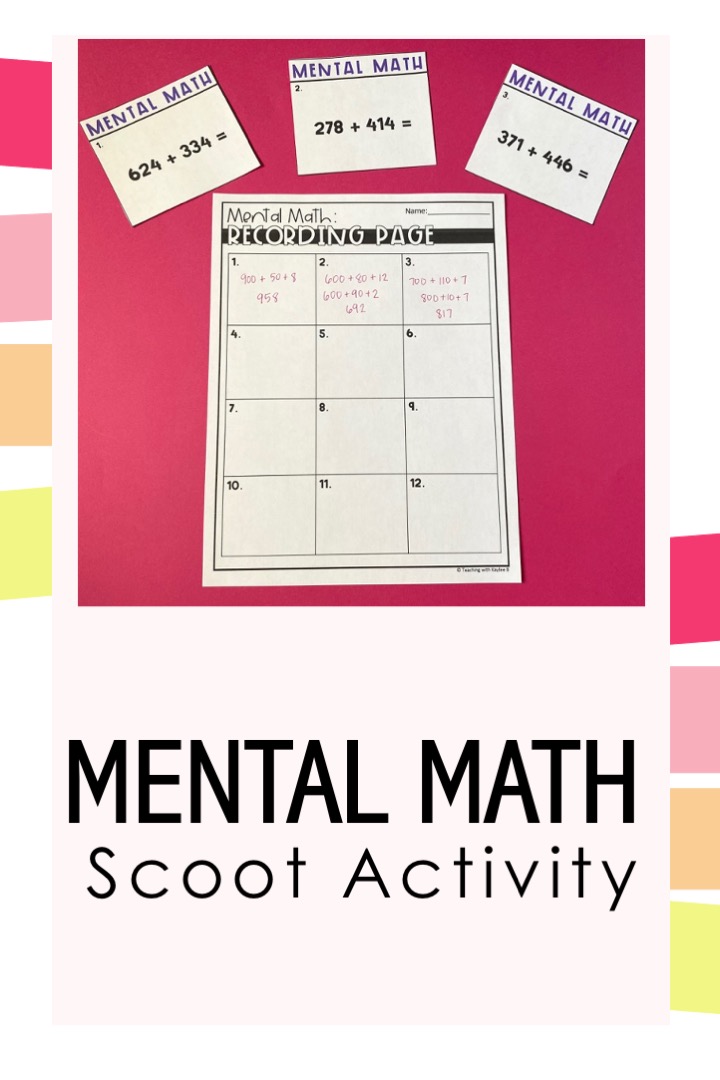
This scoot activity is a great way to provide extra mental math addition practice.
I have taped up different task cards around the classroom that have different 3-digit addition equations on them. Students have a recording sheet and go around and solve the problems using the mental math addition strategy. They write their answers on their recording sheet. I set out an answer key to this activity so students can check their own work when they are done. I love how this activity gets students up and moving!
Find this mental math addition scoot activity to use in your classroom here.
Then I keep students with those same partners and they complete a mental math addition puzzle together. This puzzle has students matching up the equations and answers they use to solve different 3-digit addition equations with this strategy.
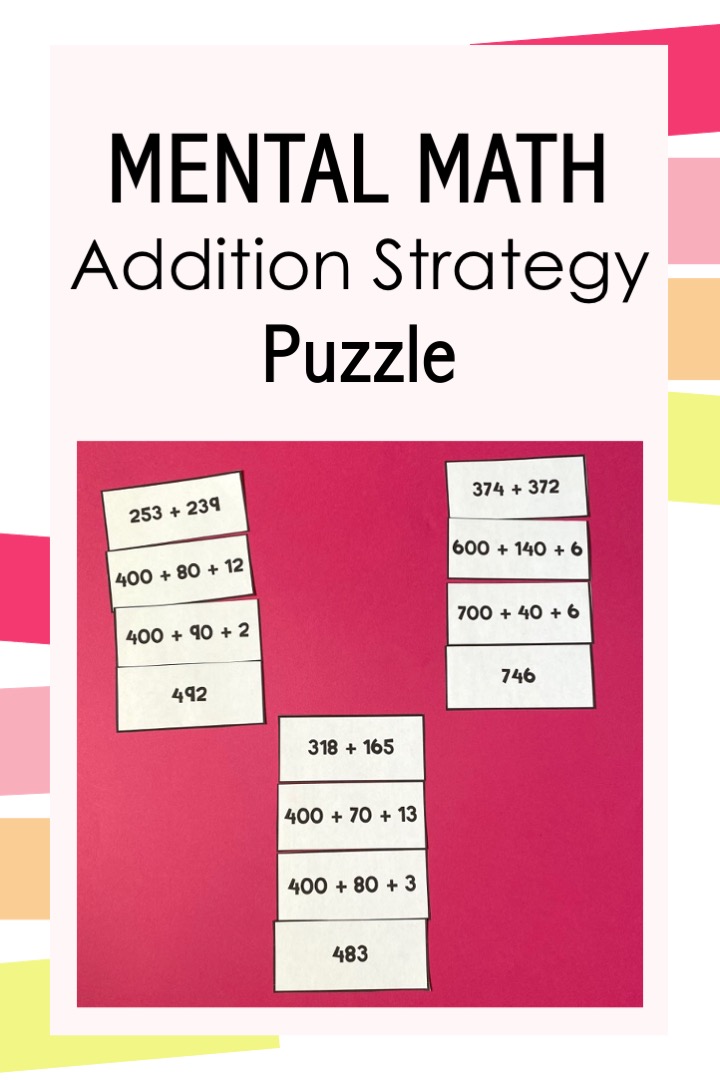
Students love completing these mental math addition strategy puzzles. I love how they help my 2nd grade students learn this strategy.
This is a fun way to get students a little extra practice in a hands-on way. But my favorite part about these is hearing my students talk about the math to each other. I’ll walk around and hear things like,“This card must go with this equation because it starts with 400 and I know 200 plus 200 equals 400” or “This equation has an extra hundred in the tens place. This card shows it transferred over to the hundreds number.”
Find these mental math addition puzzles to use with your students here.
Finally, I like to assess where my students are at with this mental math addition strategy, so I have them complete a little exit ticket. This has students solve a couple equations by themselves. I look at these later and can quickly see which students may need a little extra instruction or practice. Find the exit tickets I use here.
Students love this mental math addition strategy. With a little practice, most students can actually do it in their heads and it becomes one of their favorite strategies. Find all of the resources I use to teach this strategy to my 2nd graders here.
This isn’t the only 3-digit addition strategy I teach to my 2nd grade students. I also teach the open number line strategy, partial sums, and regrouping. Find all of my 3-digit addition strategies resources in this money-saving bundle here.
Learn my best tips for teaching the open number line strategy in this blog post here: Open Number Line Strategy: How to Best Teach it Using 3-Digit Numbers
I also have another blog post sharing more about mental math strategies with math facts. Read it here: 3 Mental Math Strategies That Help With Addition and Subtraction Facts
I hope you have been able to see that it is possible to teach this strategy to 2nd graders. When you teach it explicitly and give students quality mental math addition practice activities they can get it. Find all of my resources you need to teach it here.
As an Amazon Associate I earn from qualifying purchases.
